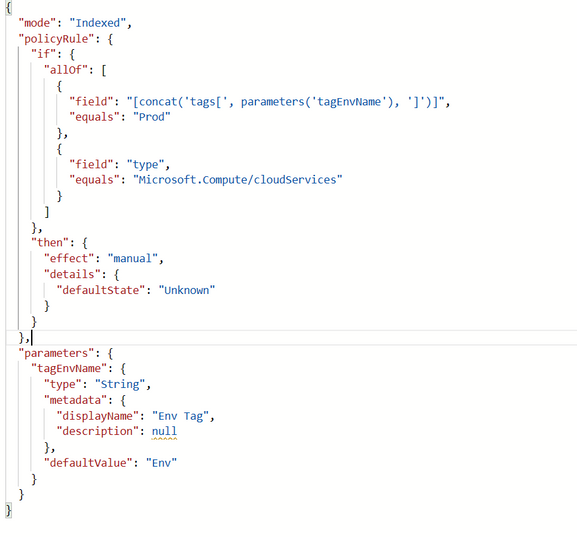Quickstart: Manual Effect in Azure Policy

Recently, a new feature called “Manual effect” popped out to users and it is still in the PREVIEW stage. It allows users to self-attest the compliance of resources or scopes. In another word, it gives users a chance to determine the compliance result of the specific resource and the reason. Currently, it is mostly used inside the Security related built-in policies and initiatives. In this post, I will briefly introduce what it looks like and how it works.
There are multiple built-in policies under the Security category to check the subscription level compliance results with manual effect. For the built-in example, you may check “Issue public key certificates” (policy definition ID: /providers/Microsoft.Authorization/policyDefinitions/97d91b33-7050-237b-3e23-a77d57d84e13). This policy only scans the target subscriptions but does not make any additional evaluation. It gives the control to users to change the compliance results for each target subscription.
Following is a custom policy example to illustrate how to use the manual effect and what is the result.
- Policy definition with manual effect
To illustrate the whole steps clearly, I created a custom policy which is checking the cloud services with “Prod” tag value. I set this custom policy with manual effect whose defaultState value is “Unknown”.
You can also use “Compliant” or “Non-compliant” as the defaultState. All applicable resources will be set to the default state specified in the definition.
The following screenshot is the evaluation results after this policy was assigned to my subscription. You can see the cloud service with “Prod” tag is marked as “Unknown”, the defaultState mentioned with the manual effect.
- Setting the compliance status by creating an attestation with REST API
You need to create attestations for each resource to change the compliance results of a resource or scope targeted by a manual policy. Currently, the only supported way to operate the attestation is through REST API.
In this example, I changed this cloud service compliance from the “Unknown” status to “Compliant” with the following REST API:
Attestations - Create Or Update At Resource - REST API (Azure Policy) | Microsoft Learn
You need to fill in the target resource information and the required evaluation result in the request body. The completed parameter list and their explanation can be found in the above doc link.
Following is an example to change the resource status from “Unknown” to “Compliant” with REST API.
Below is the request body being used for the example above:
{
"properties": {
"policyAssignmentId": "/subscriptions/xx",
"complianceState": "Compliant",
"expiresOn": "2023-06-15T00:00:00Z",
"owner": "the owner principal ID",
"comments": "test one cses to Compliant from Unknown",
"evidence": [
{
"description": "test one CSESto Compliant from Unknown",
"sourceUri": "https://gist.github.com/contoso/9573e238762c60166c090ae16b814011"
}
],
"assessmentDate": "2022-12-26T06:25:00Z",
}
}
- Updated compliance result
After the new assessment is completed, you will see the target resource has been changed to the required compliant result.
Reference Doc: Understand how effects work - Azure Policy | Microsoft Learn
Published on:
Learn moreRelated posts
Azure VMware Solution - Using Log Analytics With NSX-T Firewall Logs
Azure VMware Solution How To Series: Monitoring Azure VMware Solution Overview Requirements Lab Environment Tagging & Groups Kusto ...
Troubleshoot your apps faster with App Service using Microsoft Copilot for Azure | Azure Friday
This video provides you with a comprehensive overview of how to troubleshoot your apps faster with App Service utilizing Microsoft Copilot for...
Looking to optimize and manage your cloud resources? Join our Azure optimization skills challenge!
If you're looking for an effective way to optimize and manage your cloud resources, then join the Azure Optimization Cloud Skills Challenge or...
Have a safe coffee chat with your documentation using Azure AI Services | JavaScript Day 2024
In the Azure Developers JavaScript Day 2024, Maya Shavin a Senior Software Engineer at Microsoft, presented a session c...
Azure Cosmos DB Keyboard Shortcuts for Faster Workflows | Data Explorer
Azure Cosmos DB Data Explorer just got a whole lot easier to work with thanks to its new keyboard shortcuts. This update was designed to make ...
How to Use Azure Virtual Network Manager's UDR Management Feature
What will you learn in this blog? What is Azure Virtual Network Manager’s UDR management feature? How UDR management simplifies route setting...
Secure & Reliable Canonical Workloads on Azure | GA Availability
With Azure's partnership with Canonical, the industry standard for patching Linux distributions on the cloud is elevated. The collaboration hi...
Azure VMware Solution now available in Italy North, Switzerland North and UAE North
Azure VMware Solution continues to expand its reach, as it is now accessible in Italy North, Switzerland North, and UAE North. With this expan...
Connecting Azure to Mainframes with Low Latency
Many organizations are running their mission critical workloads on the mainframe and would greatly benefit by incorporating the mainframe in t...




